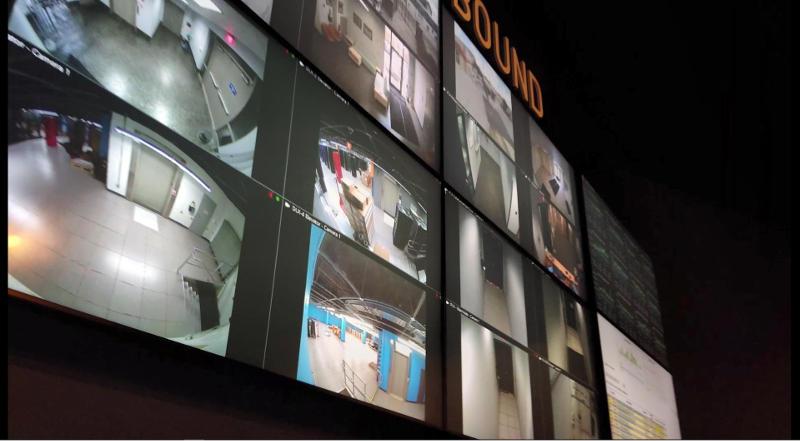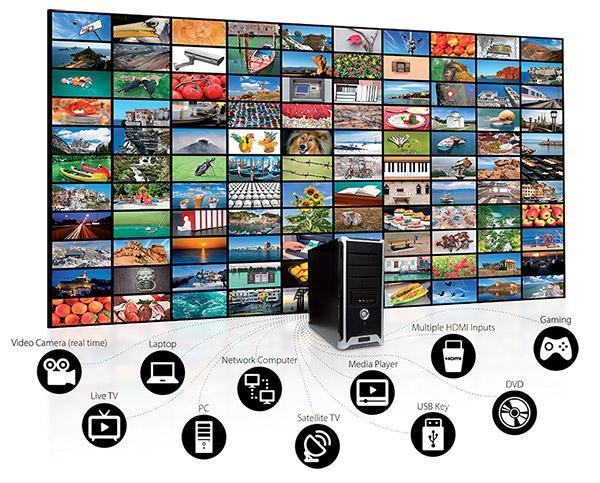HDMI Matrix Switchers and Splitters vs Network-Based Systems
The Leading Provider of AV as a Service (AVaaS)

The video wall market is a diverse one, with plenty of solutions, each of which has its own advantages and of course its own limitations.
Our blog posts always strive to provide as much information as possible to help you make the right, well-informed decision when it comes to choosing the appropriate video wall solution for your project.
In this week’s blog, we want to focus on the two main methods of distributing content to your displays: 1) HDMI matrix switchers and splitters, and 2) Network-based systems (AV-over-IP).
HDMI video wall splitters and matrix switchers
The Matrix switcher and the video wall splitter have both been around a long time.
These two might be considered the grandfathers of video wall solutions, though they are still in common use.
They are likely the simplest way to deploy a video wall.
The main drawback of this approach is that in their simplicity both splitters and matrix switchers are in fact quite limited in what they can accomplish.
Let’s look at both in detail.
HDMI video wall splitters take a source input and distribute it across several outputs.
They come as a piece of hardware, preconfigured and pretested, and they are usually plug-and-play.
In the case of a video wall, one output connects to each display and the device splits the image and sends the corresponding output to each screen.
In terms of inputs, a splitter is limited to only one HDMI connector, which limits your content options (you can connect a media player, or a PC to manage your content, but that means adding more devices to the equation, which increases the costs and complexity).
To solve the issue with multiple inputs some people turn to a matrix switcher.
These are basically splitters that can take multiple input sources at once and distribute them across multiple displays.
Matrix switchers are still proprietary hardware devices.
As a result, they are limited in the number of input and outputs they support—if you want to increase the number of outputs, you would need to daisy chain several devices (usually up to 32-64 outputs total).
Drawbacks of HDMI splitters and matrix switchers
The input/output limitations on the Matrix switcher or video wall splitter solutions significantly limit the type of deployments they could be used for.
The other key shortcoming of matrix switcher and video wall splitter solutions is that they’re limited in their management and configuration options.
They are really just relay systems that connect screens to a source.
Most HDMI splitters can only support grid video walls, with all displays having the same orientation—portrait or landscape—and with a 16:9 aspect ratio (meaning that video walls need to have the same number of columns and rows).
Most matrix switchers and splitters lack advanced features like display alignment and calibration, and none support interactive features.
Video walls are a big investment.
Purchasing a matrix switcher or a splitter will only give you a bare-bones solution without the bells and whistles that give the flexibility, scalability, and feature set customers to expect in a video wall today.
Matrix switchers and video wall splitters are mainly used for digital signage applications, where customers show a single video and do not change it (and if they need to change it, it would have to be either manually, or using an additional device/application to do the switching).

Network-based (AV-over-IP)
Over the past several years, Network-based video walls have been revolutionizing the video wall industry, due to their flexibility, power, and simplicity.
But how does that work?
Instead of using proprietary “black box” hardware, the AV-over-IP approach leverages the use of standard PC and Local Area Network (LAN) architecture.
How is the network better?
In the case of the Userful video wall, the software installs on the PC, turning it into a browser-managed appliance with all the features any video wall deployment could need.
The PC not only splits the content and delivers it to the video wall displays, it also acts as a media player—capturing and managing multiple source content—giving users more control and power over their video walls.
The advantage of using a standard, non-specialized, off-the-shelf PC is that it makes the system more cost-effective, makes deployment and training easier, and ensures ongoing support and maintenance is simpler.
Note that while HDMI splitters and switches have a limited number of inputs and outputs, Network-based systems (such as Userful’s video wall controller) are only limited by the power of the PC or server (which nowadays can be really powerful) and the bandwidth of the network (i.e. a single Intel Core i7 PC can power up to 100 screens through a 10-gig network).
Distance limitation is no longer a significant issue since Cat6 ethernet cables can run up ~330ft (more than 6 times the length of HDMI cables) without losing significant quality.
The network-based approach allows customers to install the PC in a remote location (i.e. a server room, or closet) away from the video wall site.
In the case of Userful, a small zero client receiver—which basically is a network addressable video card— is attached to the back of each display to receive the content via ethernet, outputting it to the display via HDMI.
These have no CPU or movable parts (which make for a long lifespan of 8-10 years), and pose no limitation on what content resolution the system can support (i.e. 4k, 6k, and even 8k).
When it comes to controlling and management of your video walls, because the solution is PC-based, it includes software that offers a wide range of configurations, as well content management and interactivity features.
For example, users can create any imaginable video wall layout (traditional grid or artistic).
Users can also take advantage of layout flexibility using zones, multi-window, or picture in picture to display multiple content sources simultaneously (as opposed to HDMI splitters that can only handle a single input source at a time).
Every video wall deployment is different, and depending on your requirements one approach might fit best, yet as we saw above, the PC and network-based approach is more flexible, making it more suitable for a wider range of use cases—whether it is digital signage, control rooms, artistic video walls, etc—and, even though you might think it would be more expensive, it turns out to be more cost-effective.
If you want to know exactly how cost-effective, visit Userful’s pricing page for exact pricing.
Userful
The Leading Provider of AV as a Service (AVaaS)